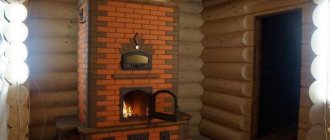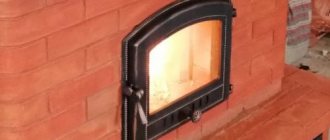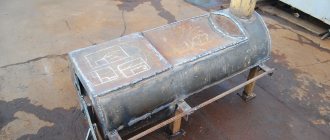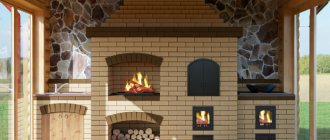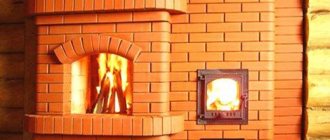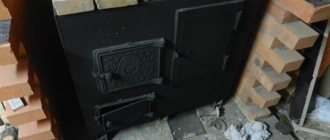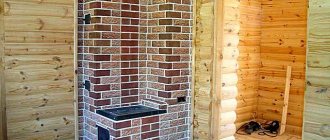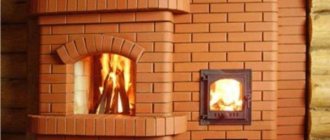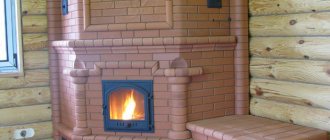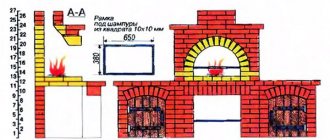Repairing a brick stove in a country house with your own hands is quite possible. Is it possible to give a second chance to a heating stove that stood at the dacha for ten years without major repairs and was the only source of heat for the dacha house. In principle it is possible. Here we will introduce you to how you can repair a brick oven without the expense of calling specialists. We repair the stove ourselves!
To do this you need:
1) conduct a visual inspection of the furnace.
2) Decide what needs to be changed.
3) Determine what else may well serve.
Today we will repair a brick oven. In this case, a stove complex, which is located on two floors of a dacha.
The secret of lining the firebox
To prevent the row of tiles from sagging down, we place a 25 mm angle into the masonry groove. Its thickness is approximately 4 mm, which is the row spacing of the tiles. The door fittings will completely cover the space not covered by tiles, and the corner itself will prevent the tiles from sliding off. After the glue has set, carefully remove the corner from the masonry.
Here is the secret to gluing the tiles - the corners are installed above the view and above the firebox.
Pay special attention to the “synchronism” of the rows of tiles; they should go one after another from one wall of the oven to the other.
Grouting joints
Approximately 10 - 12 hours later, after the glue has completely set, we need to grout the joints. We remove all the crosses (spacers between the tiles) and apply grout. You can use Ceresit Grout - it is heat-resistant. It is sold ready-to-use, white, so that its color matches the color of the tile - add a little chocolate color to give the desired shade. Apply using the continuous method. As much as necessary will sit in the seams, the rest of it will then be removed from the surface of the tile.
We grouted the seams of the stove façade. We wait three hours and remove the grout with a damp cloth or sponge. Everything should be easy to remove from the surface of the tile.
Be careful. Once you leave the grout on the tiles too long, you will no longer be able to remove it without the help of abrasives. And this, in turn, can seriously ruin the appearance.
Installation of furnace fittings
Let's start installing the furnace fittings. We take all of it from one manufacturer, I used the Finnish company SVT. For decoration we use Senegal porcelain stoneware steps 50*50 mm. This is a fairly durable and heavy material, but it looks very expensive.
We finish the pipe and the top of the stove with porcelain stoneware.
The technology is like this. We apply glue, the same as for tiles. We screw self-tapping screws into the masonry seam, place the slabs on them and then tighten everything with tape around the pipe. We leave it for a day, remove the tape, check the reliability, unscrew the screws - it turned out very impressive!
End view of the second floor oven.
The final touch. We install the cooking accessories - the hob, the firebox door and the vent. We secure everything using concrete dowels.
If you compare what was and what has become, I can’t even believe that repairing a brick oven was able to bring it back to “life”!
We invite you to watch the video:
Troubleshooting minor problems
We advise you to remember that regular inspection of the stove before the heating season and routine repairs are a way to prevent possible serious damage to the structure in the future.
What minor problems can you encounter while operating your oven and how can you fix them?
Impossibility of kindling due to lack of draft.
This problem may occur due to the following reasons:
- the stove had not been used for a long time, and cold air had accumulated inside the chimney;
- there is no air flow to support combustion;
- exposure to strong wind from the street;
- soot clogged the chimneys.
Solution: we light the stove not with paper, but with a piece of rubber or dry fuel.
Attention! The use of kerosene or other flammable liquids is prohibited.
In case of a clogged chimney, the following measures must be taken:
- light the stove;
- pour coarse salt into the firebox (about a handful);
- close the damper immediately;
- the soot will fly out in pieces into the chimney pipe.
If this method does not help, then you need to clean the pipe yourself by opening a special door or taking out knockout bricks. Experienced stove craftsmen will always leave the doors or knockout bricks behind for cleaning.
To determine where these same bricks are located , do the following:
- carry out an external inspection of the furnace; especially in places where smoke ducts pass;
- knockout brick is usually offset slightly outward, in contrast to the main masonry;
- clean out the old mortar and remove the brick. This will make the smoke channel accessible and you can clean it;
- then reinstall the knockout brick and coat it with clay mortar.
The seams of the brickwork are leaking,
As a result, the stove began to smoke.
In addition, her appearance is ruined.
How can this defect be easily recognized?
Fire up the stove and you will notice cracks that will have to be covered by hand.
Sequencing:
- soak the seams and then clear them by 2 - 3 cm;
- brush the walls using clean water;
- prepare the solution by mixing clay, sand, asbestos fiber and salt (at the rate of 100 grams per 3 liters of mixture); an indicator of a quality solution is average viscosity. You can purchase ready-made mortar at a hardware store;
- fill the seams with a clay mixture, compact it, wiping out all the voids;
- if necessary, plaster the walls, whitewash or tile.
A brick fell out or burned out.
It needs to be replaced with a new one.
Sequencing:
- clean clay and dust from the place where the old brick lay;
- moisten the area with water and place a clay cake on it;
- wet the new brick, coat its top and sides with a clay mixture (we prepare it first in the same way as for filling cracks);
- lay it instead of damaged old brick.
You need to know this
Before you start sealing the seams, you need to prepare them: remove residual clay, rinse thoroughly with water using a brush, then prime with heat-resistant glue (50% solution is suitable). When grouting joints, you need to ensure that the repair mixture fills the joints completely, leaving no voids. If a gap is too large in the masonry, in addition to the mixture, you also need to place a ceramic cord into it. Due to its physical properties, it not only withstands open fire, but also very high temperatures - over 1000 degrees.
Ceramic cord is often counterfeited, so before purchasing it, you need to hold a lit match or lighter to it to evaluate the heat resistance of the product. The cord is placed in the masonry seams around the perimeter of the cast iron slab, using heat-resistant glue for fixation.
Elimination of serious defects
Sometimes the damage to a brick kiln is so serious that it is necessary to restore it to full functionality, replace or improve the broken parts.
We replace the lining.
Lining is nothing more than protecting the surface of the furnace from various mechanical and thermal damage. In our case, this is the use of fireclay bricks.
If the firebox lining is damaged, it must be replaced.
Important! For old and new masonry, use uniform bricks so that the coefficient of thermal expansion does not change.
Simple work can be done through the firebox door. To do this, it is enough to restore the damaged areas with a clay mortar or a factory-made fireproof mixture.
Partial replacement of bricks is carried out in the following sequence:
- prepare the mortar that was used during construction;
- soak and clear the old mortar in the required area;
- remove an element that has been damaged;
- insert a new brick into the empty space and cover it well.
For these manipulations, a ready-made refractory mortar can also be used - Chamotte Mortar, which consists of chamotte and refractory clay. Then the seams of the furnace will be able to withstand more than 1700 degrees.
Complete replacement of the lining is carried out only after dismantling the wall. The main masonry should not be affected.
Sequencing:
- disassemble the wall from the hearth to the ash hole; do not touch the oven ribs;
- remove remaining crushed stone;
- lay out a new lining of fireclay bricks so that it does not tie with the material of the stove body. Maintain a seam thickness of no more than two millimeters.
- if the oven is large, lay the brick flat. If small or medium - on the edge.
We repair the chimney.
This may require plastering the masonry or even rebuilding it in case of destruction.
We switch the stove to another type of fuel.
The basic method is to line the firebox walls with fireclay bricks using fireproof mortar. Install slopes on the sides of the firebox. During the heating process, hot coals will fall down along them and close the grate.
It is important to use only high-quality bricks.
See the problem
When inspecting the furnace, the following facts may be revealed:
- The device does not have an additional blower, the so-called letnik, which enhances the stove draft when it is lit.
- Changing the location of the blower: instead of the lower part of the firebox (under the door), it is located at the end of the stove.
It is worth noting that such problems always negatively affect the flow of oxygen and the efficiency of the furnace, which significantly worsens its combustion.
In addition, there may be no additional hood above the hob, and the heating of the room is less on the side where another wall is located. These errors also need to be corrected.
The second disadvantage is the location of the view relative to the smoke channel going up. From an ergonomic point of view, this valve cannot be positioned horizontally all the time. This leads to disruption of its operation or, as stove makers aptly put it, to “tears of the stove.” The fact is that in winter, especially during frosts, a lot of condensate accumulates in the equipment, which, mixing with soot, turns into a solution of high concentration carbonic acid, which leads to the gradual destruction of the masonry.
Common mistakes
There are many nuances and difficulties in installing a stove. This process is not as simple as it might seem at first glance. Everything must be done correctly so that there are no accidents during operation.
In the bathhouse, the stove is heated very hot, and there are wooden elements and a high temperature, so for safety you need to observe the insulation as correctly as possible. All connections and installation must be done correctly and efficiently. This work is difficult, responsible and dangerous. Therefore, it is not easy to cope with such a matter alone.
When purchasing a stove in a store, they always offer installation, but some people want to do everything themselves, so they make many mistakes.
With a small area, some build baths close to other buildings, which makes a big mistake. To protect against accidents, the pipe at the bathhouse should be higher than all other buildings, and a grate should be installed on top to extinguish sparks.
Remember, repairs must be carried out in accordance with all safety regulations.
Video description
Oven for frying. How to put terracotta on glue.
On a note! In order not to make a mistake with the choice of grout, it is better to use ordinary clay, but first it should be checked for fat content. They do it this way: take five parts of clay and mix each of them with sand in different proportions, diluting with water. Then they make a bun from each mixture and throw it on the ground. The one that crashed is the fattest. Accordingly, the composition is ideal for sealing furnaces.
Useful tips
Laying of the furnace of an improved (with a stove in a hearth) Russian stove: a - general view of the stove; b - 1st row, c - 2nd row; d - 7th row; 1, 3 — pads; 2—1st row of main chimney; 4—stove ash pan; 5—stops.
We offer you some tips to help ensure high-quality maintenance of the furnace with your own hands:
- Any DIY repair, from filling cracks to replacing bricks, should only be started when the stove is warm. That is, the stove should be heated a little beforehand.
- You can check the plasticity of clay in the following way if, after rubbing it between your fingers, you still cannot determine anything. The mixture of clay and water must be stirred with a wooden plank. If the layer of clay on it is thick, then you need to add another portion of sand to the solution.
- If the appearance of cracks and deterioration of the masonry is associated with external reasons, then the stove requires not routine, but major repairs in order to avoid repeated problems. Major repairs can also be done with your own hands, or you can seek help from a specialist.
- The location of the blockage in the chimney can be determined by heating the stove or by passing a wire through the doors to clean out the soot. Current repairs are unlikely to help you in this case.
- To ensure that the ceramic heat-resistant cord does not burn out during the first use, check its fire resistance at the time of purchase. Feel free to ask the seller to check it for you.
Since ancient times, there have been recipes for preparing good mortar for bricklaying. To make it flexible and lay down evenly, add a chicken egg and a little liquid dishwashing detergent to the prepared solution. The consistency of the solution should resemble thick sour cream and be without lumps.
The solution should be laid in an even layer, without bald spots or voids, since hot air entering such an “air pocket” can contribute to the appearance of cracks.
All about do-it-yourself mortar for masonry and grouting cracks
What mortar should I use for laying stoves?
Stages of removing old whitewash: a – moistening with a roller; b – removing the whitewash layer with a spatula.
For ovens, it is necessary to use a clay solution. It is perfect not only for cleaning cracks, but also for laying bricks. The proportions of the solution should be calculated as follows. Depending on the fat content of the clay, 1-3 volumes of sand are required per volume of clay, and you will also need water.
A day before starting work, the clay needs to be soaked, then add as much water until you get a consistency similar to a creamy mass. All light impurities will float to the surface, so the solution must be filtered through a special sieve. Only after this can sand be added to the clay and mixed until all the puddles disappear.
You should not add the entire volume of sand at once; it is better to add it in small portions. A good oven mortar should not eventually crack.
How to avoid cracks in stove plaster?
Since the plaster must withstand constant temperature changes, the solution must be durable and resistant to cracking. For plastering the following are most often used:
- lime-clay;
- lime-gypsum;
- cement-clay-sand mortars.
To any type of mixture, additional materials must be added: fiberglass, foam, asbestos or straw.
There is no consensus on salt, so its use comes down to personal discretion. Date: September 25, 2022
How to prevent cracks in your cooktop
In heating and cooking stove designs, the “sore spot” is the cast iron hob. Cracks in the panel themselves do not interfere with the operation of the stove. If it is folded correctly, it has good traction and cracks do not cause any inconvenience. But - for the time being. If the design of the stove is broken or there are errors in the masonry, then carbon monoxide can leak through these cracks. And this is a big threat to the lives of people who are in the room.
As a rule, high-quality cast iron panels almost never crack. But it's better to be safe.
In order to prevent cracks from appearing on the panel, the first heating of the stove with a new hob is done carefully, warmed up slowly, without loading the entire firebox. To distribute heat evenly over the panel, pour a thick layer of sand on it, or lay out a brick. Remove the sand or remove the brick from the panel only after it has completely cooled. A uniformly loaded panel will “sit down” without distortions, which means there will be no “stress” cracks in it.
How to cover up cracks: stages of work
When the solution is ready, you can begin to cover up the defects.
The steps for repairing cracks are as follows:
- preheat the oven (until warm, not hot);
- the cracks are widened;
- thoroughly cleaned from dust and dirt;
- be sure to moisten with plenty of water;
- cover with the prepared solution.
Further heating is possible only after the solution has completely dried. But this should be done at most halfway through the fuel load. After the fuel has burned in the “light” mode, you can heat the stove as usual.
Attention: it is better not to simply cover the cracks in the brickwork with mortar, but to first lay them with asbestos cord. When working with asbestos, you must use a protective mask.
Thus, to learn how to repair a brick stove with your own hands, you must study the procedure and composition of the solution.
Restoration of a metal stove
Fireplaces and stoves made of metal can also crack. Owners do not always notice cracks on the walls due to their small size, but such a defect is signaled by the smoke that appears in the room during the fire.
In such cases, a welding machine will not always help. The problem is easier to solve with the help of a special putty-sealant, ready-made or made by yourself.
The basis of purchased heat-resistant sealants is silicone; additives determine the properties of the paste:
- Fire-resistant grades contain iron oxide; such compositions have a reddish-brown tint. They are used where the heating is maximum.
Applying sealant Source insales.ru
- Neutral sealants are needed at the joints of brick (concrete) and metal elements. When drying, they lose moisture and alcohol, after which they acquire the necessary strength.
- Acidic compounds are not used on metal surfaces. As they dry, they release acetic acid and start the corrosion process on the metal.
There are recipes for making your own sealant paste. They are quite complex in composition and require precise proportions between ingredients. However, the result is not always acceptable, since the components may contain impurities.
Only high-quality materials Source rusolymp.ru
Redecoration and decoration
The following materials are usually used for the exterior design of the stove:
- Heat-resistant tiles. Before laying this material, prepare the base of the walls: they must be cleaned and level. For ease of installation, it is recommended to use construction crosses for the seams. The tile combines well with various bas-relief edgings and frescoes. The advantages of this material are ease of care, durability and external beauty.
- Special enamel paint. To decorate the walls of the stove, you can use white paint, which can withstand significant temperature fluctuations. This fireproof paint will last quite a long time. Additional images of a different color are often applied on top of the main background. To do this, you can use ready-made stencils, or paint the oven with aerosols. You need to be prepared for the fact that the first time heating a stove with painted enamel will be accompanied by the appearance of an unpleasant odor.
Whitewash or lime. To make your stove snow-white and shiny, add salt to the aqueous solution of lime. The advantages of whitewash and lime are that these natural antiseptics have a beneficial effect on human health. As the whitewashed stove operates, no harmful toxins will be released.
What to do if cravings worsen?
Good stable draft is necessary to maintain the correct combustion mode, which requires the supply of the required amount of oxygen to the firebox and the unhindered removal of combustion products - smoke, soot, soot, as well as gases formed during the combustion of fuel.
During the construction of the furnace, gas ducts (chimneys) of the required size are installed, capable of passing the amount of smoke that is generated during the combustion of fuel. But, over time, a thick layer of soot accumulates on the walls of the flues, which reduces the cross-section of the chimney and prevents the free passage of exhaust flue gases, creating additional resistance to their movement.
As a rule, the appearance of a large amount of soot is associated with the use of firewood containing a large amount of resinous substances, which do not have time to burn completely and fall out on the walls in the form of layers of soot. Damp firewood also produces a large amount of soot.
To improve draft in this case, cleaning the pipe that removes smoke from the firebox will help. You can read how to do this in the article “How to clean a bathhouse chimney.” Also, the draft may be disrupted due to leaks in the stove lining, cracks in the walls and in the masonry of the chimney. Moreover, destruction of the masonry can occur not only within the heated room, but also outside the building - if the pipe masonry on the roof cracks and collapses, the draft will also be disrupted. How to eliminate cracks that appear, read below.
Troubleshooting Medium Problems
Sometimes, if the oven is damaged to a moderate degree, it is impossible to do without independently repairing and strengthening some parts.
Gaps around the firebox door.
Mechanical stress and temperature changes can lead to the formation of cracks around the firebox door or hob. As a result, dangerous gases penetrate outside.
These places need compaction.
Sequencing:
- clean the surface, remove the old solution;
- rinse and prime it with heat-resistant glue diluted with the same volume of liquid;
- secure an asbestos or ceramic cord around the door or hob to prevent the clay from cracking.
- rub the necessary areas with the repair mixture;
- dry for at least a day.
Tip: to check whether the fire cord has been tampered with, light it right at the cash register.
You can eliminate cracks around the hob using the same algorithm. Before removing the stove, heat the oven. Then pry up the metal using an axe. It is permissible to replace asbestos cord with basalt wool or felt. If the old stove is completely worn out, replace it with a new one .
Strengthening the frame.
This becomes necessary if gaps and cracks are located around the entire perimeter of the stove . In this case, it is best to re-arrange the masonry, but if there is not enough time, you can resort to screeding the frame using metal wire.
Sequencing:
- we dig special channels in the oven with a depth of 15 to 20 millimeters strictly horizontally;
- we lay wire in the grooves so that it provides a tie to the frame;
- we stretch the wire, twisting it with a beard or a thick nail so that it does not break;
- Plaster the stove.
Replacing the grate.
When replacing the grate, keep in mind that there must be a gap between the masonry and the grate. It must be covered with sand. The new grate should be exactly the same size as the old one.
Replacement of pre-furnace sheets.
This manipulation should only be performed when the sheets become perforated or rusty. Sequencing:
- removing the old sheet;
- removing nails;
- laying a piece of felt that was previously soaked in a clay solution;
- nailing a new sheet.
